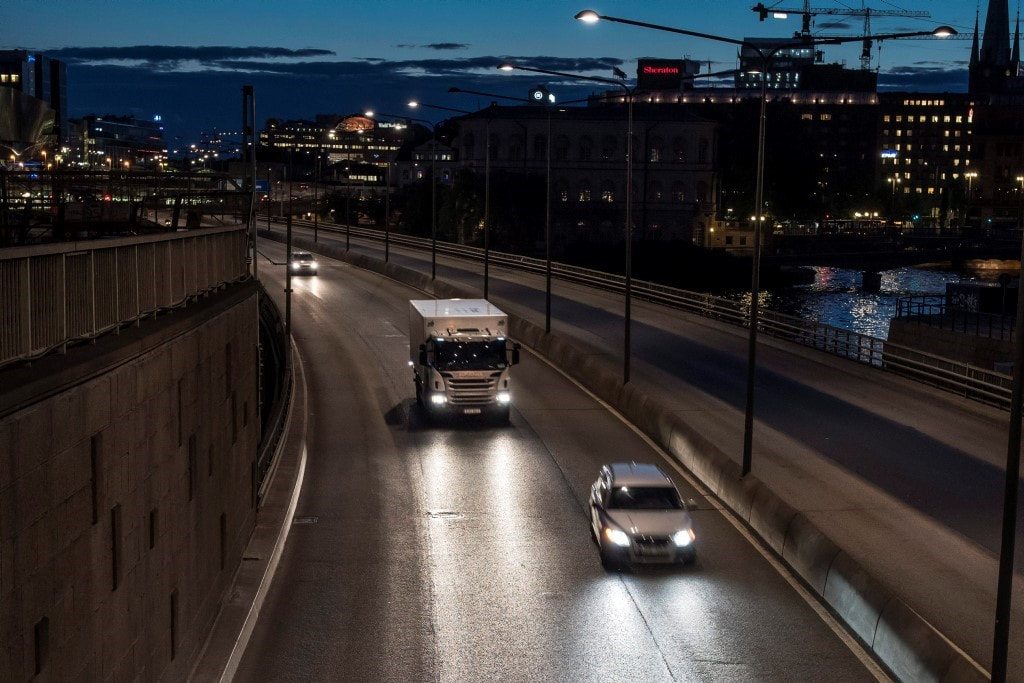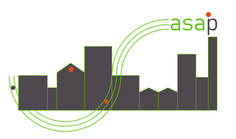Stockholm | Night time Logistics
Description
Night-time deliveries in Stockholm made possible through driving in a silent electric mode significantly reduce delivery time and result in lower emissions of carbon dioxide, nitrogen oxide and particulate matter.
The City of Stockholm has a general ban on heavy truck traffic from 22:00 to 06:00. In a project, which is partly financed by EU, the city of Stockholm, together with HAVI logistics, McDonald’s, Scania and the Royal Institute of Technology set out to demonstrate the effects from zero emission off-peak deliveries in Stockholm.
With Scania’s hybrid plug-in vehicle, the city granted an exception to test the effects of night-time deliveries. The deliveries to six downtown McDonald’s restaurants were carried out by HAVI Logistics.
Operations took place from January 2019 until the end of August 2019 and was evaluated short after. The performance was compared with corresponding deliveries using four Scania Euro 5 and Euro 6 delivery trucks as reference.
During this period, HAVI Logistics carried out three weekly delivery routes from its warehouse, 22 kilometres from inner-city Stockholm. En route from the warehouse, the truck was driven on the biofuel HVO and upon entering the city the geofencing system automatically triggered the truck to switch to an electric mode. It was also possible for the truck to additionally charge batteries while making deliveries to one of the restaurants.
The evaluation showed that the average time saved using off-peak deliveries was 30% compared to the average daytime equivalent transport route. When comparing the savings to deliveries from the narrower timespan 07:00 to 12:00, the difference was even bigger – 38%. Off-peak deliveries both with hybrid and non-hybrid trucks generally contribute to lower emission due to easier parking at delivery points, less queuing, higher speeds and more frequent green lights at intersections.
The reference trucks were all operatied on renewable HVO (Hydrotreated Vegetable Oil. HVO already reduced carbon emissions by 90% compared with conventional fossil diesel. Carbon emissions for off-peak deliveries with the Scania hybrid truck were on average an additional 44 % lower than for the reference vehicles, primarily due to the electronic motor.
The results for other emissions are equally encouraging with particulate matter – PM10 – emissions down by 28% and nitrogen oxide emissions reduced by more than 80 percent. The very large reductions are mainly due to less time spent driving and queuing but also partly due to the inclusion of Euro 5 trucks as reference vehicle.
As part of the evaluation, HAVI Logistics’ driver was asked to comment on the benefits of night-time deliveries. “It’s much easier to drive due to less traffic, simpler manoeuvring and fewer other vehicles to consider”, he said. “Parking is also with more space and the restaurant staff welcome these deliveries at night since there are fewer customers, which gives them time to receive goods less stressfully.
“This shows the potential for remarkable transport efficiencies and societal benefits of utilising off-peak deliveries,” the evaluation concludes.
The City of Stockholm has a general ban on heavy truck traffic from 22:00 to 06:00. In a project, which is partly financed by EU, the city of Stockholm, together with HAVI logistics, McDonald’s, Scania and the Royal Institute of Technology set out to demonstrate the effects from zero emission off-peak deliveries in Stockholm.
With Scania’s hybrid plug-in vehicle, the city granted an exception to test the effects of night-time deliveries. The deliveries to six downtown McDonald’s restaurants were carried out by HAVI Logistics.
Operations took place from January 2019 until the end of August 2019 and was evaluated short after. The performance was compared with corresponding deliveries using four Scania Euro 5 and Euro 6 delivery trucks as reference.
During this period, HAVI Logistics carried out three weekly delivery routes from its warehouse, 22 kilometres from inner-city Stockholm. En route from the warehouse, the truck was driven on the biofuel HVO and upon entering the city the geofencing system automatically triggered the truck to switch to an electric mode. It was also possible for the truck to additionally charge batteries while making deliveries to one of the restaurants.
The evaluation showed that the average time saved using off-peak deliveries was 30% compared to the average daytime equivalent transport route. When comparing the savings to deliveries from the narrower timespan 07:00 to 12:00, the difference was even bigger – 38%. Off-peak deliveries both with hybrid and non-hybrid trucks generally contribute to lower emission due to easier parking at delivery points, less queuing, higher speeds and more frequent green lights at intersections.
The reference trucks were all operatied on renewable HVO (Hydrotreated Vegetable Oil. HVO already reduced carbon emissions by 90% compared with conventional fossil diesel. Carbon emissions for off-peak deliveries with the Scania hybrid truck were on average an additional 44 % lower than for the reference vehicles, primarily due to the electronic motor.
The results for other emissions are equally encouraging with particulate matter – PM10 – emissions down by 28% and nitrogen oxide emissions reduced by more than 80 percent. The very large reductions are mainly due to less time spent driving and queuing but also partly due to the inclusion of Euro 5 trucks as reference vehicle.
As part of the evaluation, HAVI Logistics’ driver was asked to comment on the benefits of night-time deliveries. “It’s much easier to drive due to less traffic, simpler manoeuvring and fewer other vehicles to consider”, he said. “Parking is also with more space and the restaurant staff welcome these deliveries at night since there are fewer customers, which gives them time to receive goods less stressfully.
“This shows the potential for remarkable transport efficiencies and societal benefits of utilising off-peak deliveries,” the evaluation concludes.
Innovation and Relevance
Off-peak deliveries are a good example of an under-utilised asset. By preforming deliveries on off-peak hours, the full potential of the existing infrastructure is used more efficiently.
Relation to other urban Logistics Projects
“Off-peak City Logistics – A case study in Stockholm” (Pernestål et al.) is a prior project carried out in Stockholm. It reported about a similar transport efficiency evaluation that took place in 2017. This study was a combination of both a Volvo electric truck and a Scania biogas truck. The KPIs were similar in regard to transport efficiency, but the methodology was partly different. Instead of creating a reference route with help of geofence zones, an actual reference route was driven and recorded with GPS positioning and noise equipment. While this is a strong method for creating a comparison, the sample size was smaller than the one used for this evaluation.
The overall conclusion from the project is that the benefits from off-peak deliveries exceed the costs. The results from the project suggest that the concept of off-peak deliveries is beneficiary in the Stockholm region, and the off-peak delivery program is suggested to continue and be scaled up to involve more vehicles and other types of goods.
The overall conclusion from the project is that the benefits from off-peak deliveries exceed the costs. The results from the project suggest that the concept of off-peak deliveries is beneficiary in the Stockholm region, and the off-peak delivery program is suggested to continue and be scaled up to involve more vehicles and other types of goods.
Plans for Future Development
The city is continuing to grant exceptions in order for more off-peak deliveries to be carried out in the city centre. However, there are some legal boundaries for the city to permit night time deliveries on a permanent basis due to the framework that is currently in place. The city cannot perform permanent exemptions to the general ban on heavy truck traffic from 22:00 to 06:00 with regard to types of trucks, for example if you specify use of powertrain or fully electrical vehicles.
The legal framework is currently being reviewed and the city hope for a more relaxed approach to the rules in order to continue develop off-peak solutions.
The legal framework is currently being reviewed and the city hope for a more relaxed approach to the rules in order to continue develop off-peak solutions.
Impressions
Fotocredits: © Stockholm Stad



